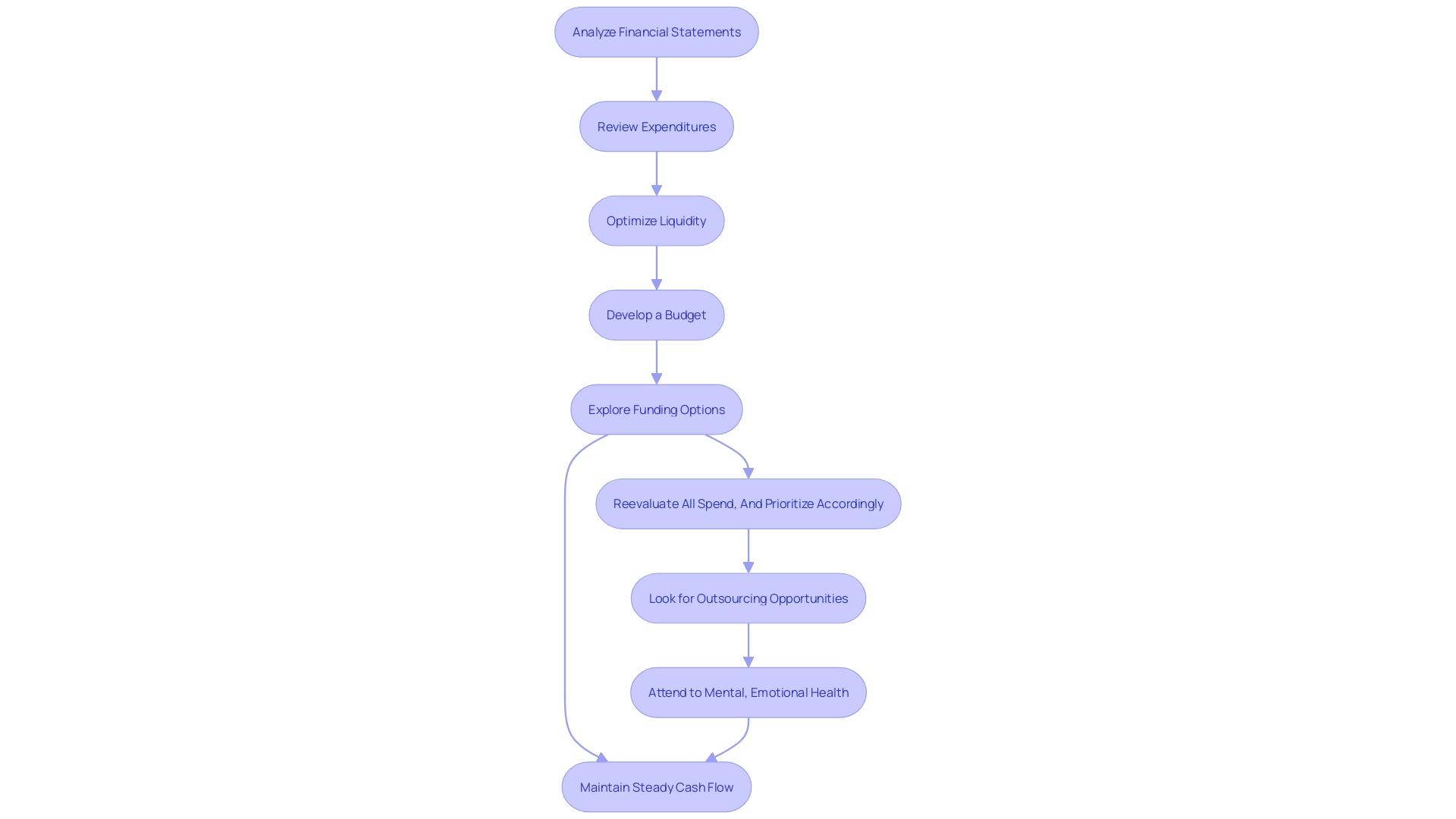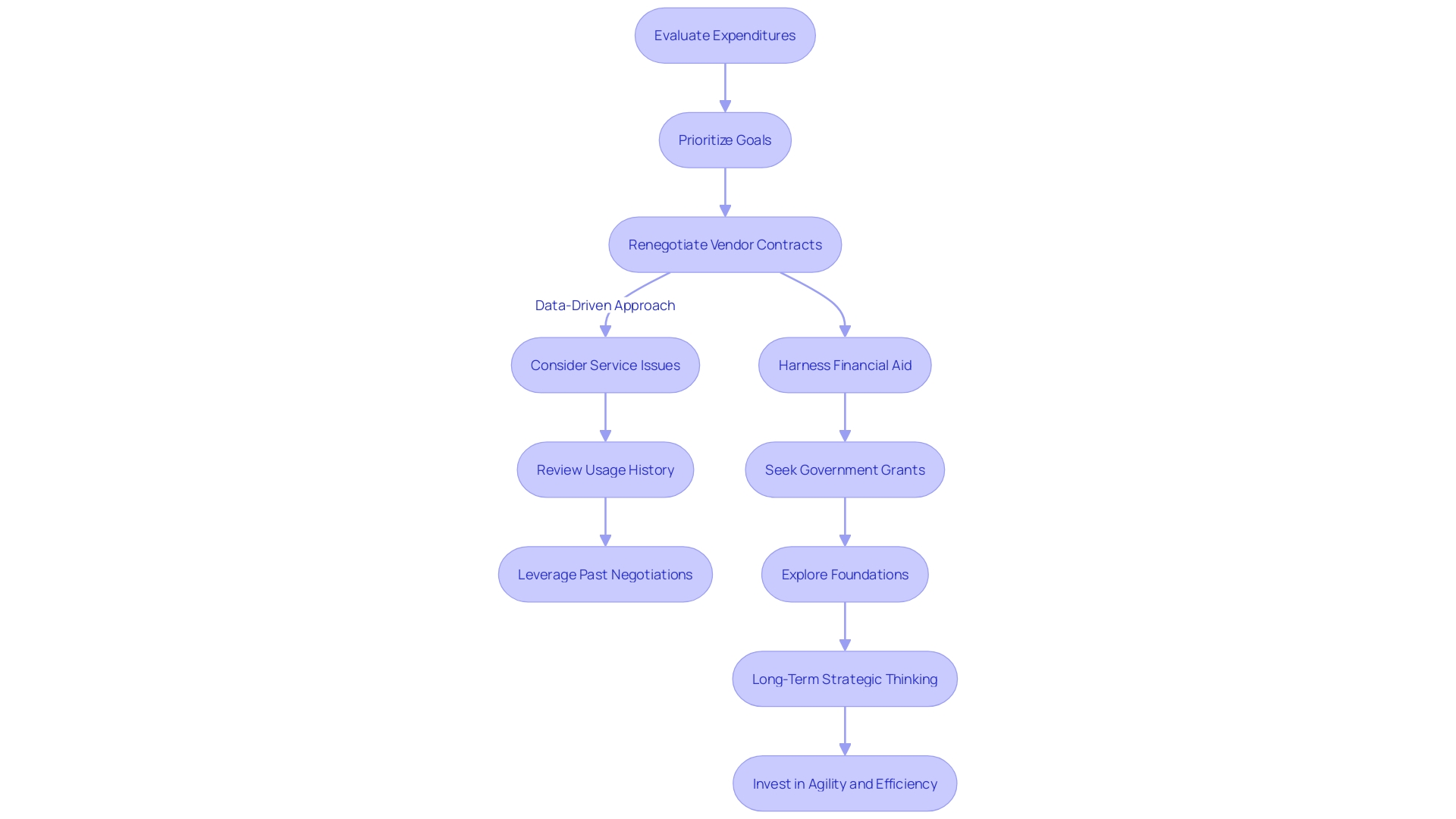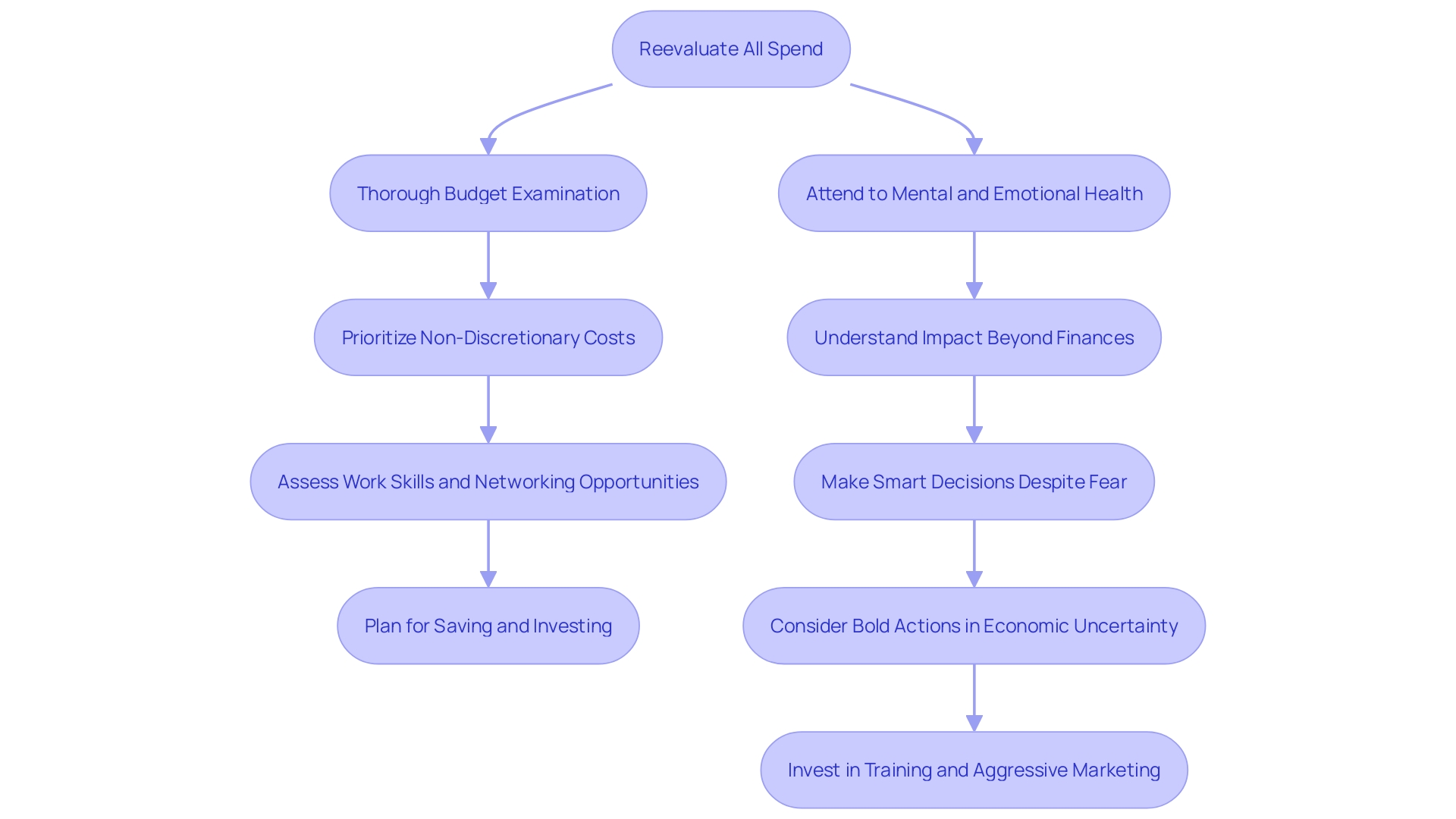Introduction
In the face of a financial crisis, taking swift and strategic action is crucial. It requires a candid evaluation of the company's financial health and understanding the need for immediate action. By reassessing spending, leveraging technology, and prioritizing employee well-being, businesses can navigate through tough times and position themselves as well-managed entities.
Rigorously evaluating the existing business plan, embracing change, and focusing on core competencies are also essential. Safeguarding cash flow, creating a compelling change story, renegotiating vendor agreements, and seeking financial assistance are key steps in overcoming a financial downturn. Implementing cost reductions, optimizing assets, revising business strategies, and increasing revenue are vital for long-term viability and success.
By following these practical and actionable steps, businesses can confidently tackle financial crises and emerge stronger.
Recognize and Acknowledge the Crisis
Facing a financial crisis requires a swift and strategic approach. The first step in this critical journey is a candid evaluation of the company's financial health. It's not just about admitting that there's a problem; it's about understanding the gravity of the situation and the immediate need for action. Take the case of an airline that experienced a complete operational breakdown due to outdated IT systems. Despite repeated warnings from employees and unions, the company had prioritized shareholder dividends over technological investments, leading to massive cancellations and customer dissatisfaction. This serves as a cautionary tale for businesses to listen to their workforce and address underlying issues before they escalate into full-blown crises.
Moreover, assessing the entire financial landscape of your company, from income to expenses, is imperative. This isn't about indiscriminate cost-cutting but rather a meticulous analysis that aligns with your long-term objectives. For instance, a financial expert emphasizes the empowerment that comes from mastering your cash flow, which begins with a deep dive into essential costs like housing, insurance, groceries, and transportation.
In the wake of economic disruptions, companies that emerge stronger are those that reassess their spending, prioritize effectively, and invest in technology to enhance efficiency. These actions not only help in navigating the crisis but also in positioning the business as a well-managed entity in the eyes of customers, partners, and employees.
In times of financial uncertainty, leveraging data to identify and address employee financial stressors is also crucial. This could involve providing resources for financial education and planning, which can improve both employee well-being and organizational productivity. Recent statistics have shown a significant uptick in company insolvencies, highlighting the need for businesses to take pre-emptive measures to secure their financial future and avoid becoming part of this growing trend.
Ultimately, the key to overcoming a financial crisis lies in a proactive stance—acknowledging the severity of the situation, re-evaluating spending, leveraging technology, and prioritizing the well-being of employees. By doing so, companies can navigate through tough times and set the stage for a successful turnaround.
Critically Evaluate Your Current Plan
To safeguard a business from financial peril, a rigorous assessment of the existing business plan is paramount. This means dissecting the current business model, revenue forecasts, and overarching strategies to pinpoint weaknesses or potential areas for enhancement. The objective is to determine the feasibility and practicality of the plan amidst the prevailing economic conditions. Should the circumstances necessitate, business leaders must be decisive, making the difficult choices and, if needed, steering the company in a new direction to adeptly manage the crisis.
Leaders in the business world have long understood that change heralds opportunity. Companies that thrive are often those helmed by CEOs who are adept at turning change into a strategic advantage. The successful transformation of a business depends on the ability to respond to change effectively. This is vividly illustrated through the experiences of corporations such as 7-Eleven and Blockbuster, where embracing change led to prosperity, while a failure to do so resulted in decline.
It's critical for businesses to ask the right questions when developing their business plans, distinguishing between short-term operational plans and long-term strategic visions. The goal is to ensure that the company is not just surviving but is also positioned to thrive and define the future landscape post-economic disruption. Executives should be forward-thinking, assessing necessary investments and divestments, and leveraging technology to enhance efficiency.
Current trends show that companies that are perceived as well-managed and profitable become more appealing to customers, partners, and employees. They are the ones likely to set the tone for the coming decades after economic upheavals. These insights are backed by the evolving landscape of startups and FinTech, where agility and swift adaptation to market changes are increasingly becoming essential for survival and growth.

Focus on Core Competencies
Navigating a financial crisis requires a proactive and targeted approach, where a company's distinct competencies become its lifeline. Consider the case of Nets, a digital payment solutions company with over half a century of experience. In their quest for innovation, they recognized the power of transforming technical data into compelling, user-friendly formats, thereby reinforcing their unique position in the market. Similarly, by concentrating on what sets your business apart, you can optimize operations and minimize extraneous costs.
Reassessing all spending is crucial, as pointed out by Alina Fisch from Contessa Capital Advisors, emphasizing the empowerment that comes from controlling cash flow. This entails a detailed evaluation of essential costs and income sources. In times of economic uncertainty, it's tempting to retrench; however, history has shown us that businesses that innovate and invest wisely during downturns often emerge stronger.
The U.S. economy's current juncture suggests preparation for a sustained recovery. Executives must consider long-term goals and the strategic investments necessary to achieve them. This includes divesting non-core assets to increase agility and utilizing technology to boost efficiency. A comprehensive strategy should encompass predictive tools that offer insights into business operations, allowing for informed decision-making during critical times.
In the end, staying within your 'circle of competence' and making investment decisions based on a robust process rather than short-term results, as suggested by investment experts, can mitigate risks and position your company for recovery. It's a matter of focusing on impactful expenditures that align with both immediate and future-focused objectives, ensuring every dollar spent is a strategic step towards revival and growth.
Protect and Manage Cash Flow
To safeguard your company during a financial downturn, decisive action on cash flow management is imperative. At the forefront of this approach is a meticulous analysis of your financial statements, as underscored by Dr. Sharon H. Porter from Vision & Purpose Lifestyle Magazine and Media, who emphasizes the importance of being well-versed in your business's performance metrics. A strategic review of all expenditures is essential, not merely as a cost-cutting exercise, but as an opportunity to align spending with your strategic objectives, thereby ensuring resources are allocated effectively to fuel growth and recovery.
It's critical to optimize liquidity without compromising long-term goals. This entails not only scrutinizing accounts receivable and renegotiating terms with suppliers but also considering each business function for potential outsourcing, which, as financial experts suggest, can lead to significant savings. Moreover, developing a comprehensive budget that covers non-discretionary costs can empower you with control over your finances, as noted by Alina Fisch from Contessa Capital Advisors.
In instances where additional funding is necessary, exploring capital raising or securing financing can provide the cushion needed to navigate through tough times. With cash flow as the lifeblood of a business, maintaining a steady stream is crucial for covering costs and enabling strategic investments for future growth, thereby preventing the devastating consequences that come with a cash shortfall.

Create a Compelling Change Story
Faced with a financial downturn, the key to rallying your team, customers, and stakeholders lies in crafting and communicating a compelling narrative of change. Begin by zeroing in on your audience; whether it's your dedicated employees, whom you can count on to rise to the occasion, or customers who need to hear about tangible responses like refunds, tailor your message to address them directly and early in your communication. Paint a vivid picture of the current challenges, detail the corrective actions in place, and articulate the envisioned positive outcomes.
A well-told story, one that's rich with context and emotional resonance, can serve as a powerful instrument to inspire confidence and foster a sense of shared purpose. For example, by taking the approach of companies like Ben & Jerry's, which communicated its values and decisions with transparency, or entrepreneurs like Sophie Thompson who leverage personal backstories to connect and build trust, you can engender support for your company's revitalization.
Remember, in our data-centric era, it's not just about having information; it's about telling a story with it that spurs action. As you collect and share data, focus on what you want your audience to learn and take away. Tailor your narrative to highlight opportunities and insights that resonate with their needs and interests. This approach can transform complex data into a story that not only informs but also compels your audience to engage with your company's journey to recovery.

Renegotiate Vendor Agreements and Seek Financial Assistance
To navigate through a financial crisis, it's imperative to take decisive and strategic actions. Begin by evaluating all expenditures and prioritize them in alignment with both current and future goals. Tackling your budget head-on gives you a clearer understanding of your financial health and empowers you to make informed decisions. A critical aspect is renegotiating vendor contracts with a data-driven approach. By analyzing service issues, usage history, and leveraging data from past negotiations, you can secure better terms, such as extended payment periods, service level agreements with penalties for delays or issues, or significant discounts to mitigate any vendor-related challenges.
Furthermore, harnessing the full potential of financial aid opportunities can provide a lifeline for struggling businesses. Keep an informed eye on grants from various sources like government entities and foundations, ensuring your proposals resonate with their specific criteria. This could mean a substantial financial boost and could also position your business favorably for future growth and stability.
Executives should also think long-term; what investments will drive agility and efficiency? Consider technology improvements and forecasting tools for a more accurate picture of business operations. By adopting a proactive stance and seeking out financial partnerships or investments, businesses can pivot towards recovery and lay the foundation for lasting success.

Implement Cost Reductions and Asset Sales
Navigating through a financial crisis requires a strategic approach to cost management and asset optimization. The first step involves a meticulous evaluation of all expenditures, ensuring alignment with strategic objectives. It is essential, however, to approach this without an immediate bias towards cost-cutting. Instead, a comprehensive review of the budget is necessary, focusing on both expenses and revenue streams. This allows for the prioritization of investments in areas that contribute to the company's strategic goals, while deferring or eliminating outlays that are no longer essential.
Key to this strategy is the concept that reductions in spending must not jeopardize the core operations of the business. This means maintaining operational efficiency and ensuring the quality of products or services remains uncompromised. When AT&T faced historical bureaucracies, they were spurred into action by employee feedback, highlighting the importance of having efficient systems and procedures in place.
The process of cost rationalization can also include the divestiture of non-core assets. This was exemplified by Intel's plan to streamline operations by selling off its programmable chip unit Altera, as part of a broader effort to reduce costs and refocus on its core business. Similarly, Pacific Steel, in a quest to control soaring healthcare costs, severed ties with traditional provider networks in favor of a reference-based pricing model, resulting in more transparent and manageable healthcare expenses.
The careful selection of assets for sale is crucial; it is about identifying those that are not integral to the primary business operations to bolster cash reserves. The statistics are telling: with the highest number of company insolvencies since 1993 recorded in 2023, the urgency for businesses to adopt sustainable cost structures has never been greater.
In summary, the goal is to create a leaner, more efficient, and sustainable cost structure that not only navigates through immediate financial difficulties but also positions the company for long-term viability and success.

Revise Business Strategy and Increase Revenue
Realigning business strategies to overcome financial challenges requires a multifaceted approach. In the dynamic food and beverage sector, resilience is built on understanding customer needs and leveraging location-based advantages. Emulating a successful strategy, a hotel restaurant near the city center optimized its potential by tailoring offerings to the demand of the local, resulting in a notable uplift in sales. This underscores the importance of knowing your market and creating a user experience that resonates with your target demographic.
Similarly, utilizing an effective technical stack like Django, Tailwind, and HTMX, combined with a focused SEO strategy, can drive traffic and increase revenue streams. This approach involves analyzing competitor traffic, refining existing content, and crafting new articles aligned with search intentions. Once a ranking is achieved, iterative testing of titles and calls to action can enhance performance further.
Key performance indicators (KPIs) are instrumental in navigating a business through fiscal turbulence. These metrics offer insights into financial health, operational efficiency, and customer satisfaction, enabling informed decision-making. The value of KPIs is echoed by management experts, who advocate for measurement as a pathway to effective management.
In challenging economic climates, collaborative innovation becomes a lifeline. By partnering with local businesses to create online marketplaces, companies can maintain cash flow and sustain operations. This strategy not only diversifies revenue but also fosters community engagement and customer loyalty.
As the business landscape evolves, so must the approach to profitability and growth. A value maximization strategy can sometimes mean sacrificing immediate profits for long-term growth, as seen in sectors like tech and green energy. This principle is applicable to companies worldwide, from Eastern European firms benefiting from market monopolies to those in China and Southeast Asia navigating competitive, low-margin markets.
For a business facing a financial crisis, these examples serve as a blueprint for strategic realignment. It's about creating a compelling user experience, harnessing the power of location, measuring what matters, and embracing collaboration—all aimed at fortifying the company's financial footing and paving the way for a successful turnaround.
Conclusion
In conclusion, navigating through a financial crisis requires swift and strategic action. It begins with a candid evaluation of the company's financial health and understanding the need for immediate action. Reassessing spending, leveraging technology, and prioritizing employee well-being are crucial steps in positioning businesses as well-managed entities.
Rigorously evaluating the existing business plan, embracing change, and focusing on core competencies are also essential. Safeguarding cash flow, creating a compelling change story, renegotiating vendor agreements, and seeking financial assistance are key steps in overcoming a financial downturn. Implementing cost reductions, optimizing assets, revising business strategies, and increasing revenue are vital for long-term viability and success.
By following these practical and actionable steps, businesses can confidently tackle financial crises and emerge stronger. It is crucial to critically evaluate the current plan, focus on core competencies, protect and manage cash flow, create a compelling change story, renegotiate vendor agreements, and seek financial assistance. These actions, combined with implementing cost reductions and asset sales, as well as revising business strategies and increasing revenue, will position companies for a successful turnaround.
By taking proactive and targeted approaches, businesses can navigate through tough times and set the stage for a brighter future. It is crucial for CFOs to be confident and action-oriented, providing practical advice and solutions to overcome financial challenges. With a clear focus on these strategies, businesses can weather the storm and emerge stronger, positioning themselves for long-term success.




